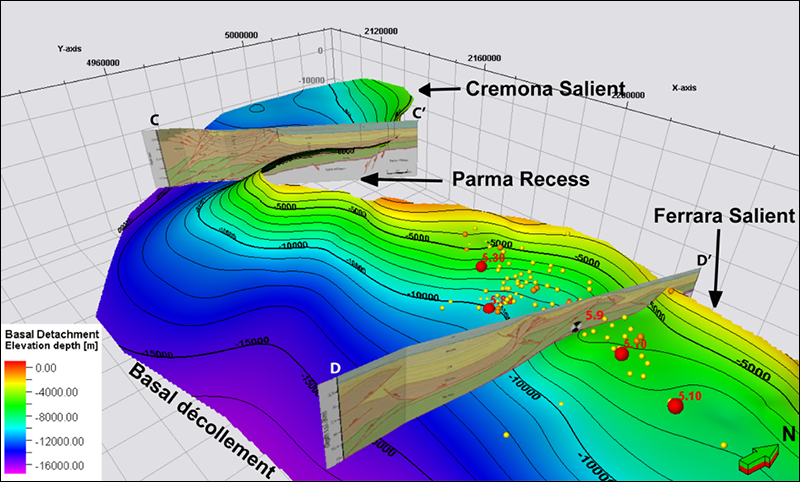Source: Journal of Geophysical Research: Solid Earth
Italy’s rugged Northern Apennine Mountains consist of a belt of deformed sedimentary rocks scraped off the top of the Adriatic microplate during subduction. Today, the fold and thrust belt, the farthest extent of this deformation, is buried beneath younger sediments in the 650-kilometer-long Po Valley, an important petroleum-producing region nestled between the Apennines and the Alps.
Rather than being linear, this buried deformation front undulates between more outward-projecting areas, called salients, and intervening embayments known as recesses. Although such features have been studied for more than 2 centuries, their origins, and the insights these may offer with respect to mountain building, are still poorly understood.
To help shed light on which factors were most important in shaping the buried Apennine deformation front, Livani et al. have reinterpreted borehole, seismic reflection, and other previously published data collected along the south side of the Po Valley, where two prominent salients are separated by the Parma recess. The researchers found clear evidence for two major gliding planes, known as décollements, in this region: a lower décollement hosted in Triassic shales and a shallower one in late Eocene-Oligocene marls.
The authors conclude that the interplay between two factors, the slope of the lower décollement and the lateral variations in the rock units hosting the two gliding horizons, is what controls the geometry of the salient-recess pattern. The two salients developed where the formations hosting the décollements are thicker and therefore allowed the thrust to propagate farther, whereas the Parma recess is associated with an area of erosion or nondeposition in the same sedimentary horizons. Salients are more pronounced where the flexural geometry of the subducting slab has generated a steeper basal décollement.

Collectively, these results indicate that the Northern Apennine fold and thrust belt was constructed via “thin-skinned” deformation, a type of crustal shortening characterized by the dislocation of cover rocks by shallow faults rather than the geologic basement, which requires deeper-seated faulting. This conclusion contrasts with previous studies that have argued the belt is the result of “thick-skinned” deformation or a combination of both tectonic styles.
This paper is an important contribution to our knowledge of not only the Northern Apennines but also the evolution of fold and thrust belts in general. It offers fresh insights into the factors that shaped this deformation front as well as the processes underpinning the evolution of this and potentially other thin-skinned mountain ranges. (Journal of Geophysical Research: Solid Earth, https://doi.org/10.1002/2017JB015235, 2018)
—Terri Cook, Freelance Writer
Citation:
Cook, T. (2018), What shaped the Northern Apennine deformation front?, Eos, 99, https://doi.org/10.1029/2018EO098925. Published on 18 May 2018.
Text © 2018. The authors. CC BY-NC-ND 3.0
Except where otherwise noted, images are subject to copyright. Any reuse without express permission from the copyright owner is prohibited.

